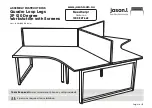
33
TRIO MP-235 THREE-AXIS MICROMANIPULATOR SYSTEM OPERATION MANUAL – REV. 2.23 (20190130) (FW V2.2 & 2.3)
sequence being transmitted to the controller must
contain an unsigned binary value. Attempting to
code command sequences as “strings” is not
advisable. Any command data being returned from
the controller must also be received and initially
treated as a sequence of unsigned byte values.
Groups of contiguous bytes can later be combined to
form larger values, as appropriate (e.g., 2 bytes into
16-bit “word”, or 4 bytes into a 32-bit “long” or
“double word”). For the TRIO MP-235, all axis
position values (number of microsteps) are stored as
“unsigned long” (32-bit) values, and each is
transmitted and received to and from the controller
as four contiguous bytes.
Axis Position Command Parameters: All axis
positional information is exchanged between the
controller and the host computer in terms of
microsteps. Conversion between microsteps and
microns (micrometers) is the responsibility of the
software running on the host computer. The
number of microsteps for any axis position must
always be exchanged between the controller and the
application running on an external computer as an
unsigned 32-bit value (“unsigned long” for C/C++
or “U32” for LabVIEW). “Unsigned” means the
value is always positive; negative values are not
allowed. An unsigned long or U32 consists of four
contiguous bytes, with a byte/bit-ordering format of
Little Endian (“Intel”) (most significant byte (MSB)
in the first byte and least significant (LSB) in the
last byte). If the platform on which your application
is running is Little Endian, then no byte order
reversal of axis position values is necessary.
Examples of platforms using Little Endian
formatting include any system using an Intel
processor (including Microsoft Windows and Apple
Mac OS X).
If the platform on which your application is running
is Big Endian (e.g., Motorola PowerPC CPU), then
these 32-bit position values must have their bytes
reverse-ordered after receiving from, or before
sending to, the controller. Examples of Big Endian
platforms include many non-Intel-based systems,
LabVIEW (regardless of operating system & CPU),
and Java (programming language/environment).
MATLAB adapts to the system on which it is
running, so Little Endian may need to be enforced if
running on a Big Endian system.
Microsteps and Microns (Micrometers): All
coordinates sent to and received from the controller
are in microsteps. To convert between microsteps
and microns (micrometers), use the following
conversion factors (multipliers):
Table
D-5
. Microns/microsteps conversion.
System/Device From/To
Units
Conversion Factor
(multiplier)
μ
steps
Æ
μ
m 0.09375
TRIO MP-235 with
TRIO MP-235/M
micromanipulator
μ
m
Æ
μ
steps 10.66666666667
For accuracy in your application, these conversion
factors should be typed as double precision
(“double”); “float” is not recommended. If the result
is in microsteps, it can be typed as a 32-bit “long”
integer; otherwise, it should be typed as floating
point, preferably as double precision (“double”).
Table
D-6
. Ranges.
Device Axis
Millimeters Microns Microsteps
X
0 – 25
0 – 25,000 0 – 266,667
Y
0 – 25
0 – 25,000 0 – 266,667
TRIO MP-235/M
D
0 – 50
0 – 50,000 0 – 533,334
Command Reference: The following table lists all
the external-control commands for the TRIO
MP-235.






































